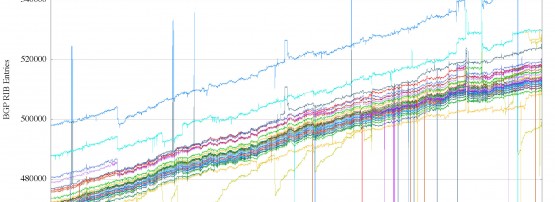
No doubt we have all heard that the Internet is really quite big. With some three billion human users and perhaps more than five billion connected devices, we could probably make the claim that the Internet represents the largest engineered artifact that humanity has ever constructed.
But how can we “see” the entirety of this network? Each of us sees a small part through the lens of our devices and the applications we use. None of these applications reach out to the entire network at once, and that means that getting a view of every part of the Internet is a challenge.
However, there is one technology that does manage to collapse the entire current state of the Internet into a single database, and replicate that picture of the Internet on hundreds of thousands of devices. That’s the Internet’s routing system.
There are a number of questions about the Internet that can be answered by closely examining the routing system. How big is the network? How many components networks are encompassed within it? Is the Internet still growing? And is this growth accelerating out of control, or is it slowing down as the Internet matures? In many parts of the world its now extremely hard to obtain IPv4 addresses. How is this constraint affecting the growth of the Internet? Has the recent emergence of markets in address transfers been effective in addressing some of this ongoing demand for IPv4 addresses? How are we going with this transition to the IPv6 protocol?
Some answers to these questions can be found in a detailed analysis of the state of the routing system across 2014. What is evident is that the Internet’s growth has slowed in 2014. In the IPv4 network it’s clear that address exhaustion in most parts of the world has acted as a very major constraint on the continued expansion of the network. The network is still growing, but its no longer doubling in size each year. The current growth rate is around some 8% to 9% per year.
The IPv6 network is still much smaller than the IPv4 network. Much has been done to convert the core of the network to support IPv6, but at the access networks at the edge there is still much to be done. The IPv6 network is one twentieth of the size of the IPv4 network, but its growth rate is more than double that of IPv4, at some 20% per year.
While the Internet has grown to a size that was entirely unanticipated when many of the basic technologies of the Internet were defined, many of these technologies were designed with an extraordinary degree of robustness. We are using a routing protocol in the form of the Border Gateway Protocol (BGP) that was originally designed in the late 1980’s, when the size of the entire Internet was a few thousand routes. In 2014 we passed over half a million routes and BGP still holds it all together. In terms of scalable technology, that’s amazing!
The full report can be found at the APNIC Labs blog
The views expressed by the authors of this blog are their own and do not necessarily reflect the views of APNIC. Please note a Code of Conduct applies to this blog.
